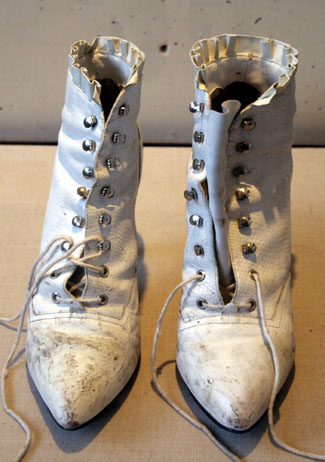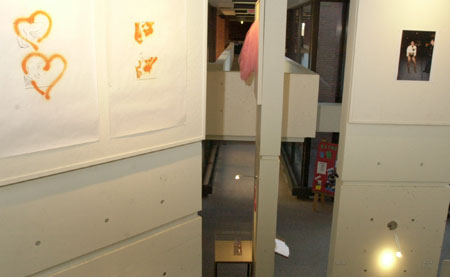Three Columns Gallery:
Exhibits at Mather spark both admiration and uproar

When Mather House Co-Master Leigh Hafrey acted on the idea to turn the House’s once-bleak common space into a vibrant art gallery, neither he nor the gallery’s principal players had any idea that their creation would become a focal point for heated debate about the role of art in public spaces.
Three Columns Gallery was the brainchild of Mather House Life Drawing Instructor Donald Shambroom. It was Shambroom, says Hafrey, who saw that the three columns in the House’s common space, which are surrounded by an open, two-story staircase, “are not performing a structural function, so that they must be here for display purposes. Donald said the space looked to him like a mini Guggenheim. It was one of those moments when you hear something and it clicks.”
Mather pottery instructor Pamela Gorgone and Mather Senior Common Room members Ken Fan and Ned Cooke, all of whom have been involved in artistic endeavors at Mather House for some time, participated in the initial discussions about the Gallery’s creation. Senior Ronald Jou ’01 created the Gallery’s logo, which is a modified Chinese character for the word “river.” Undergraduate students have written the descriptions for each of the Gallery’s four shows to date. And the Mather Arts Society, the committee that chooses the art to be displayed in Three Columns Gallery, comprises a cross-section of the Mather House community, including Hafrey, Shambroom, House Tutors Catherine Carter-Palfrey and Susanna Garcia, and students.
Three Columns Gallery had its first opening on October 5, for which were brought in two area artists, sculptor Peter Haines and painter Harry Bartnick. The show was well received, and the Gallery was off to a strong start.
But no one was prepared for the reception the Gallery’s second show was to spark, nor did Shambroom realize what he was about to start when he installed his own sculptures as part of the Constructions show.
“Almost immediately, these comments began appearing in the book we keep on a podium in the Gallery,” says Shambroom.
He is referring to anonymous notations blurting out such sentiments as “Complete garbage!” and “This exhibit makes me want to puke my brains out.”
“There was a vibe in the air,” Shambroom continues, “as if something dangerous had arrived here. Some people thought the pieces posed the threat of physical danger.”
But that peril, insists Shambroom, is only perceived. A piece entitled Gum, for instance, worried some viewers that it might topple over at any moment. Gum is a nine-foot-high wooden pedestal with a child’s chair affixed at the top. A wad of chewing gum is visible on the chair’s bottom. “It’s an illusion that this piece is hazardous and unstable,” says Shambroom. “It looks that way partially because the small chair, at that height, looks like a larger chair. Then the pedestal, because of the way the base is constructed, looks as if it might fall over easily, when in fact the base is filled with rocks and is quite stable. Yet this piece frightened some people so much that we had to attach it to one of the gallery’s walls.”
Another creation, called “The Complete Works of Charles Dickens,” is a two-shelf workbench. On the bottom shelf are 12 of the famed storyteller’s works, while the top shelf features old saw blades jutting straight up next to their dismembered handles. In some people’s minds, those saw blades became potential tools of self-destruction. “The emotional atmosphere was charged way up,” Shambroom says, “because of the form this object took. But those blades are blunt and harmless. Even if you fell on this piece you couldn’t hurt yourself at all.”

Shambroom thinks the art distressed some of its viewers “because it upset people’s notions of what art is. It’s supposed to be inside a frame, not sticking out into the space.”
Mather House principals seem to agree that the controversy was a healthy, if unexpected, development.
“It was really educational for a lot of people in the community,” Hafrey says. “We had discussed the role of public art as we were planning the Gallery, but the comment book made it real. With Three Columns Gallery, you can’t have a meal at Mather without going through the space. So the Gallery raises a lot of questions about art in people’s daily lives. Who decides what gets exhibited, how and where it gets exhibited? How much will tastes differ?”
“We held open dinner discussions to let everyone talk about their responses to the second show,” says Carter-Palfrey. “I think the controversy that Constructions inspired and the ensuing discussions were good things, even though it was unnerving at the time. It is impossible to walk through Mather House without going through the exhibition space, so I think we have to be careful to involve more students in discussions about what gets shown here.”
“We wouldn’t try to avoid controversial shows in the future,” adds Hafrey, “but we do need to ensure that we have a very public decision-making process.”
As part of their original vision of Three Columns Gallery, and as a way to involve students more closely with the Gallery, its fourth show was crafted entirely by undergraduates. The show, called “Costumes,” opened April 5. Melia Marden ’03 collaborated closely with the show’s eight student artists in writing its descriptive text. The show, Marden writes, “examines…costumes as a theme which defines and informs both fashion and art, values the dualities of presentation and production…as well as the construction of identity.”
“One of the things that’s so important about this exhibit is that there isn’t much room on campus to display student work,” notes Carter-Palfrey. The students whose art is on display at Three Columns Gallery certainly seem glad to know that there is a place where they can show their work. And at least two of the artist students feel that last winter’s controversy only helped in cultivating Three Columns Gallery – and Mather House, by extension – as a vital artistic environment.
Megan Buckingham ’03, whose video explores the displacement of pain in abuse and the sexualization of the child figure, says of the controversy, “Art that occupies people’s living space gives it a lot of power, makes people think about things. The Gallery’s potency escalates both positive and negative effects.”
Photographer Michael Wang ’03, whose work in this latest show reveals clothing as the costume of the everyday, says, “I enjoy viewing stimulating, more conceptual work every day, rather than standard decorating fare.”
Hafrey and others agree with the perspective that the controversy helped to establish Three Columns Gallery as a place to come for an interesting dialogue about art.
“The artwork that was part of last winter’s show was difficult for some people to come to terms with,” says Hafrey. “But we’re hoping that when the year is over, people will say that art is not any single one of the shows, but it is all of them. We hope that people will ask, ‘What does that range tell me about art and about my response to it?’”
Shambroom feels that the controversy generated “some of the most interesting conversations I’ve had about art in years. I didn’t expect my work to stir up a sort of subconscious riot, but frankly I’m glad it happened. People are a lot more interested in the Gallery now, and that’s a helpful outcome for all concerned.”




